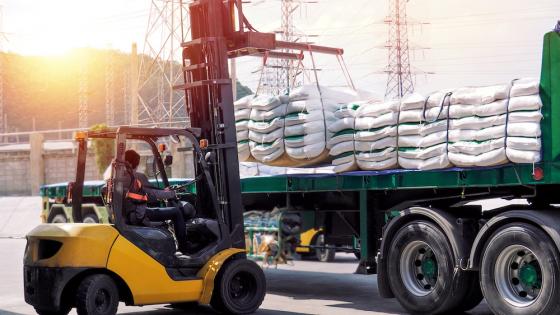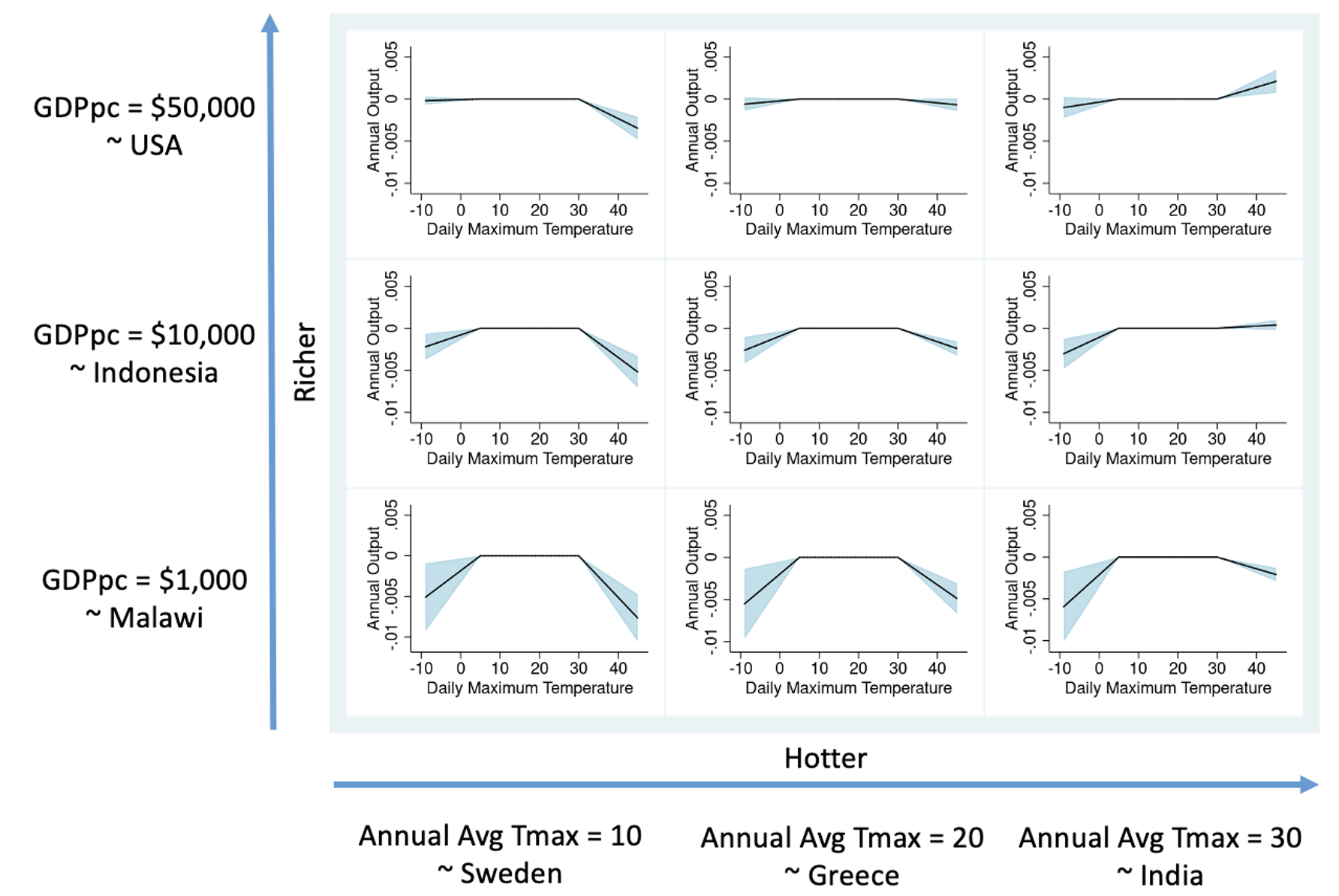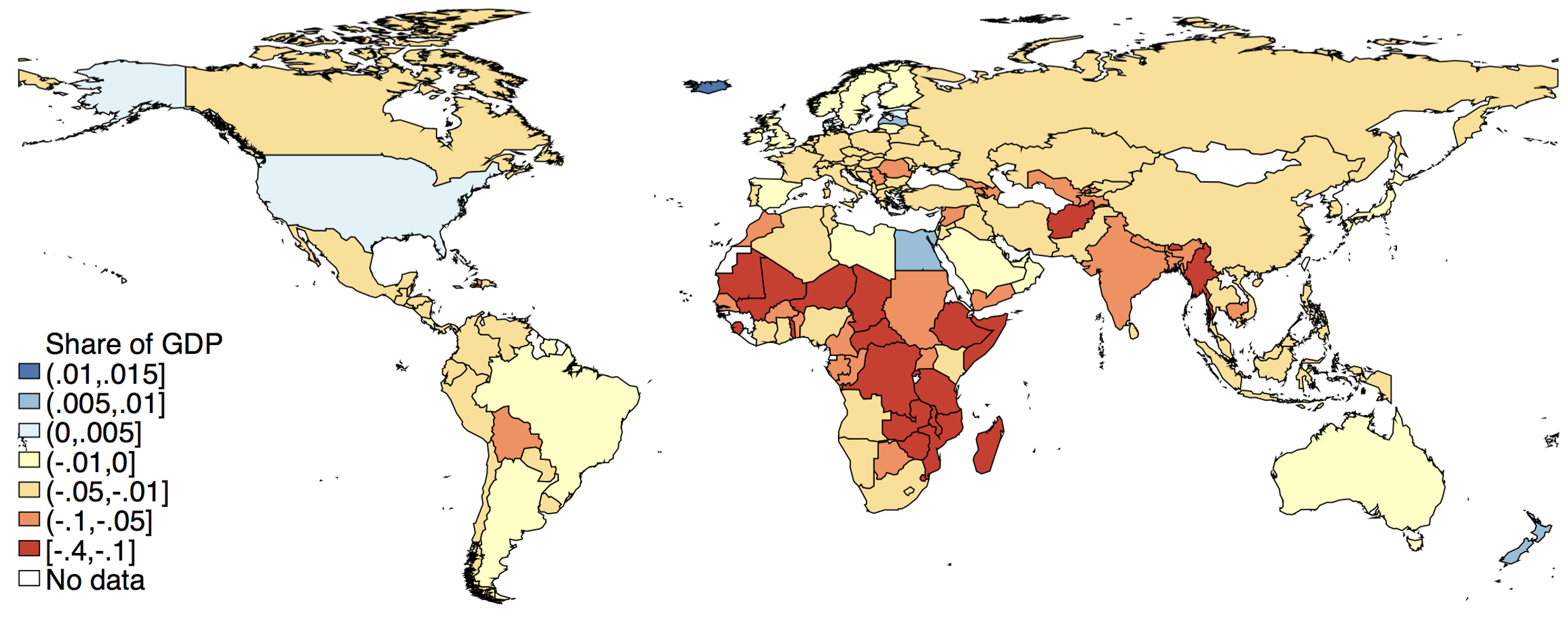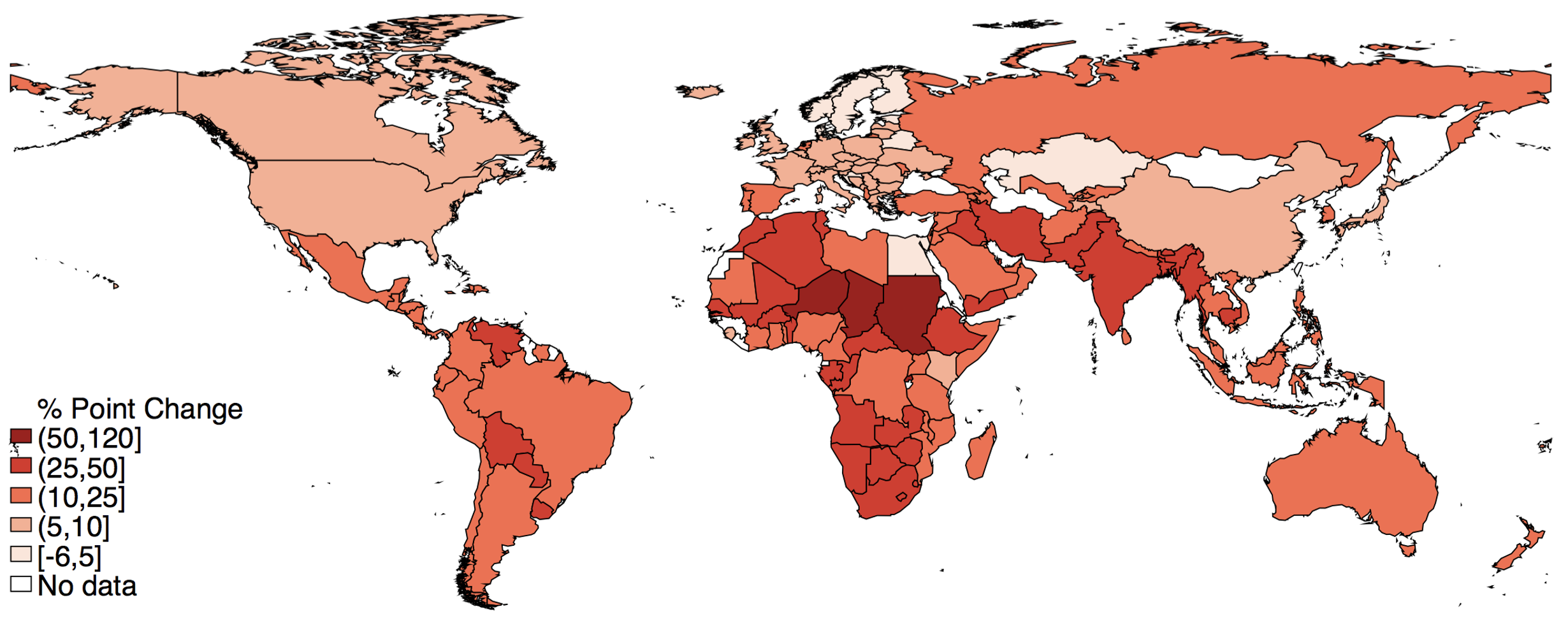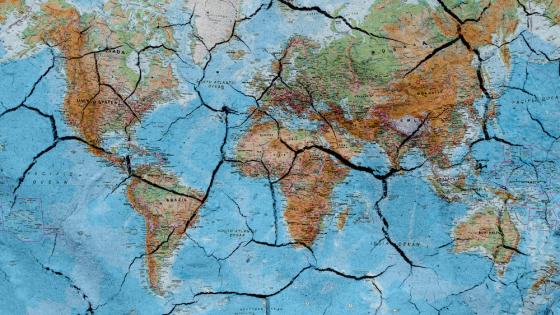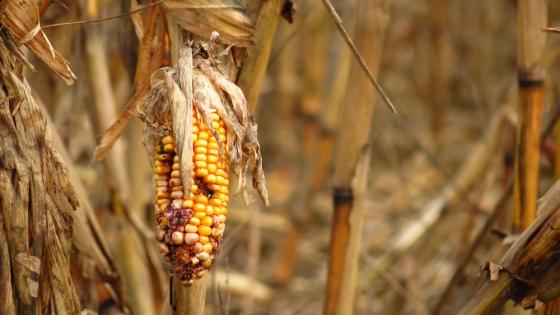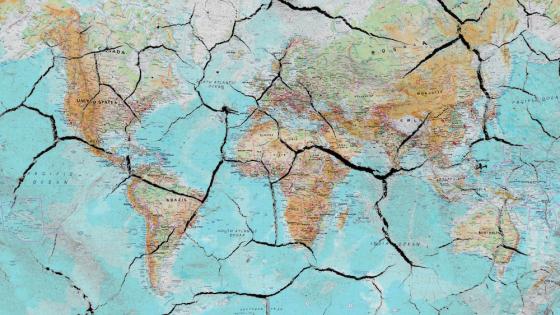A wide range of evidence suggests that global warming will have major effects on agricultural productivity throughout the world. Analysis suggests that each degree of daily temperature exposure above 30°C sharply reduces the yield of crops such as corn, soybeans, and wheat (Schlenker and Roberts 2009). As the world gets hotter, rising temperatures are projected to cause great damage to vulnerable crops and regions.
Farmers might be able to mitigate some of the harm global warming causes to agriculture by re-optimising their production decisions in response to changing conditions. Research by Arnaud Costinot et al. (2016) uses granular field-level global projections from the UN Food and Agricultural Organization of crop-specific potential yields with and without climate change to estimate how farmers could reallocate planting decisions as temperature and precipitation change. Their work finds large projected gains from shifting production away from the most affected crops. As the world warms, gradual evolution in the crop mix chosen by local producers in the coming decades could substantially offset some of the potential losses.
Just as some crops suffer disproportionately from global warming, some regions do too. In the hottest parts of the world, even perfectly optimised planting decisions will likely be insufficient to protect agricultural production from future extremes. For example, Costinot et al. find that climate change will reduce agricultural productivity in Malawi by about 50% later this century in a high-emissions scenario, even when farmers re-optimise their future crop allocations. Similarly, empirical research by Schlenker and Lobell (2010) finds severe impacts across a wide range of crops in sub-Saharan Africa. As temperatures rise in the hottest and poorest parts of the world, the outlook for agricultural production appears bleak.
Could the hottest, most vulnerable countries adapt to climate change by shifting their economies away from agriculture altogether? The same research that suggests rising temperatures could devastate agriculture in hot, poor countries also implies that farming in more temperate regions, like Canada or Russia, could benefit somewhat. This suggests that hot countries could adapt effectively to global warming if they could move labour into non-agricultural sectors and increase imports of food, with agricultural specialisation across the world shifting away from the equator. Conversely, if regions hit hard by extreme heat, such as those in South Asia and sub-Saharan Africa, continue to specialise heavily in farming as they do today, their economies and people will likely suffer greatly. My research (Nath 2021) quantifies the potential adaptation gains from reallocating global agricultural specialisation, and examines whether such gains are likely to be realised in practice.
In order for hot countries to adapt to global warming by shifting production away from agriculture, the first requirement is for non-agricultural production to be less vulnerable than farming to extreme heat, such that comparative advantage in agriculture – not just absolute advantage – shifts away from the equator. Given that existing work (e.g. Somanathan et al. 2021, Zhang et al. 2018) finds that temperature also affects manufacturing productivity, it is not immediately clear whether hot places have any potential to gain by moving away from farming.
My analysis addresses this question. Using firm-level panel data from 17 countries spanning a wide range of income levels and climate conditions to estimate the impact of future temperature extremes on labour productivity in manufacturing and services, I find that warming is likely to reduce productivity much less in non-agricultural sectors than in agriculture. While some firms in poorer countries can suffer large productivity losses from exposure to extreme heat – up to 0.4 percentage point reductions in annual revenue per worker from each exposure to a day above 100°F – firms in richer countries and places that experience heat more frequently appear to have adapted such that they are much less vulnerable. Figure 1 shows the estimated effects of extreme temperatures on manufacturing productivity across the full range of local contexts.
Figure 1 Impact of extreme temperatures on labour productivity in manufacturing across global contexts
On average, my paper projects, rising temperatures will reduce global manufacturing productivity by about 1.7% by late century in the high-emissions scenario. By contrast, previous estimates across a range of studies suggest that the corresponding decline in agricultural productivity will be about 20% (e.g. Cline 2007, Iglesias and Rosenzweig 2010). In the hardest hit countries, future temperature extremes reduce manufacturing productivity by about 5–14% in manufacturing, as compared to 40–60% in agriculture. This suggests that hotter, poorer countries could achieve large adaptation benefits if they were able to reallocate production away from farming and toward less-affected manufacturing sectors as the climate heats up.
But there is a second condition required for the global reallocation of agriculture to contribute to climate change adaptation: specialisation in agriculture must actually respond to shifting comparative advantage. In practice, the patterns of agricultural specialisation we observe in the world today do not seem to follow traditional definitions of comparative advantage. While the simplest Ricardian model would predict that countries specialise in the sector with higher relative productivity, the opposite appears to be the case in the data. Lagakos and Waugh (2013) calculate that the 90th-percentile richest countries in the world have an average price-adjusted value-added per worker four times greater than the 10th-percentile poorest countries in manufacturing, but 45 times greater in agriculture. In other words, if relative productivities predicted specialisation, we would already expect most of Canada’s economy to be in farming and for there to be very few farmers in Malawi, even without climate change. And yet, agriculture’s share of employment averages 65% in 10th-percentile countries, and only 3% in 90th-percentile countries.
Why do poor countries specialise in agriculture despite their low productivity? Gollin et al. (2007), among others in the macro-development literature, refer to this phenomenon as “the food problem”. The basic idea is that because food is a subsistence good, people with low incomes in poor countries with relatively high food prices must spend a larger share of their budget on eating enough food to survive. For supply to meet demand in such places, these high expenditure shares on food necessarily require high production shares in agriculture, at least in the absence of trade. In principle, poor countries with unproductive farms could meet domestic demand for food through imports, but in practice this mechanism is extremely weak in most developing countries. The stylised fact calculated in my paper is that the average person in the poorest quartile of the world consumes 91% domestically produced food compared with 45% in the richest quartile. In these relatively closed economies, high production shares in agriculture follow from the need for domestic populations to meet their subsistence needs to eat.
The exceedingly low levels of trade in poor countries stand as a critical barrier to climate change adaptation. Instead of agricultural specialisation shifting away from the hardest-hit regions as the world heats up, my model projections suggest that warming will keep more workers stuck on farms in hotter, poorer countries as falling agricultural productivity in these places exacerbates the food problem. As climate change makes people poorer and food more expensive, it raises the budget share and consequently the production share of agriculture in the absence of a major increase in food imports. With production remaining concentrated in the sector experiencing dramatic declines in productivity, people in these places project to suffer greatly. Figure 2 shows that projected climate damages in many poor countries approach or exceed 10% of income just from the effects of rising temperatures on productivity (excluding other climate harms, such as health effects or hurricane damages). Figure 3 shows the corresponding large projected increases in food prices in poor countries, as domestic consumption of food continues to rely on increasingly vulnerable domestic agricultural production.
Figure 2 Willingness-to-pay to avoid the productivity effects of future extreme temperatures
Figure 3 Projected impact of global warming on domestic food price index
The model projections in my paper suggest that trade does very little to cushion climate impacts, largely because the places that are most vulnerable to global warming are also least open to trade, so warming causes only modest adjustments in trade flows. I also consider an alternative hypothetical scenario in which poor countries trade as freely as richer countries in the OECD. In that scenario, the developing world moves dramatically toward importing food and shifting specialisation toward less vulnerable non-agricultural sectors, and the costs of rising temperatures are nearly 70% lower for the poorest quartile of the world. While the exact magnitude of such model projections should be interpreted with caution, as they extrapolate far from the patterns of trade we observe today, these estimates do imply that greater global openness to trade could substantially reduce the damage from a warming world. More research is needed on the particular causes of low levels of trade in poor countries; with tariffs, poor quality infrastructure, and red tape barriers such as processing delays, fees, and bribe payments all likely playing important roles. My analysis suggests that understanding the mechanisms and potential policy instruments that facilitate greater global openness to trade could have critical implications for climate change adaptation.
More broadly, as the literature on climate-change economics evolves, applications of spatial economics are playing an increasing role in analysing potential mechanisms of adaptation. In other examples, work by Cruz and Rossi-Hansberg (2021) considers the role of international migration, Desmet et al. (2021) evaluates how sea level rise affects coastal populations and investment, and Rudik et al. (2021) focuses on spatial dynamics within the US. Reducing carbon emissions is the best and only reliable way to avoid the threat posed by global warming, but as long as global climate policy remains insufficient to reverse the trajectory of rising emissions, there is an increasing need for research on reducing vulnerability to whatever temperature change occurs over the coming century.
References
Cline, W (2007), Global Warming and Agriculture: End-of-Century Estimates by Country, Peterson Institute.
Costinot, A, D Donaldson and C Smith (2016), “Evolving comparative advantage and the impact of climate change in agricultural markets: Evidence from 1.7 million fields around the world”, Journal of Political Economy 124(1): 205–248.
Cruz, J-L and E Rossi-Hansberg (2021), “The Economic Geography of Global Warming”, NBER Working Paper 28466.
Desmet, K, R Kopp, S Kulp, D Nagy, M Oppenheimer, E Rossi-Hansberg and B Strauss (2021), “Evaluating the Economic Cost of Coastal Flooding”, American Economic Journal: Macroeconomics 13(2): 444–486.
Gollin, D, S Parente and R Rogerson (2007), “The food problem and the evolution of international income levels”, Journal of Monetary Economics 54(4): 1230–1255.
Iglesias, A and C Rosenzweig (2010), “Effects of Climate Change on Global Food Production under Special Report on Emissions Scenarios and Socioeconomic Scenarios (SRES): Data from a Crop Modeling Study”, Technical Report, Columbia University.
Lagakos, D and M E Waugh (2013), “Selection, agriculture, and cross-country productivity differences”, American Economic Review 103(2): 948–80.
Nath, I (2021), “Climate Change, the Food Problem, and the Challenge of Adaptation through Sectoral Reallocation”, Working Paper.
Rudik, I, G Lyn, W Tan and A Ortiz-Bobea (2021), “The economic effects of climate change in dynamic spatial equilibrium”, Working Paper.
Schlenker, W and D Lobell (2010), “Robust negative impacts of climate change on African agriculture”, Environmental Research Letters 5(1): 014010.
Schlenker, W and M Roberts (2009), “Nonlinear temperature effects indicate severe damages to US crop yields under climate change”, Proceedings of the National Academy of Sciences 106(37): 15594–15598.
Somanathan, E, R Somanathan, A Sudarshan and M Tewari (2021), “The impact of temperature on productivity and labor supply: Evidence from Indian manufacturing,” Journal of Political Economy 129(6): 1797–1827.
Zhang, P, O Deschenes, K Meng and J Zhang (2018), “Temperature effects on productivity and factor reallocation: Evidence from a half million Chinese manufacturing plants”, Journal of Environmental Economics and Management 88: 1–17.
